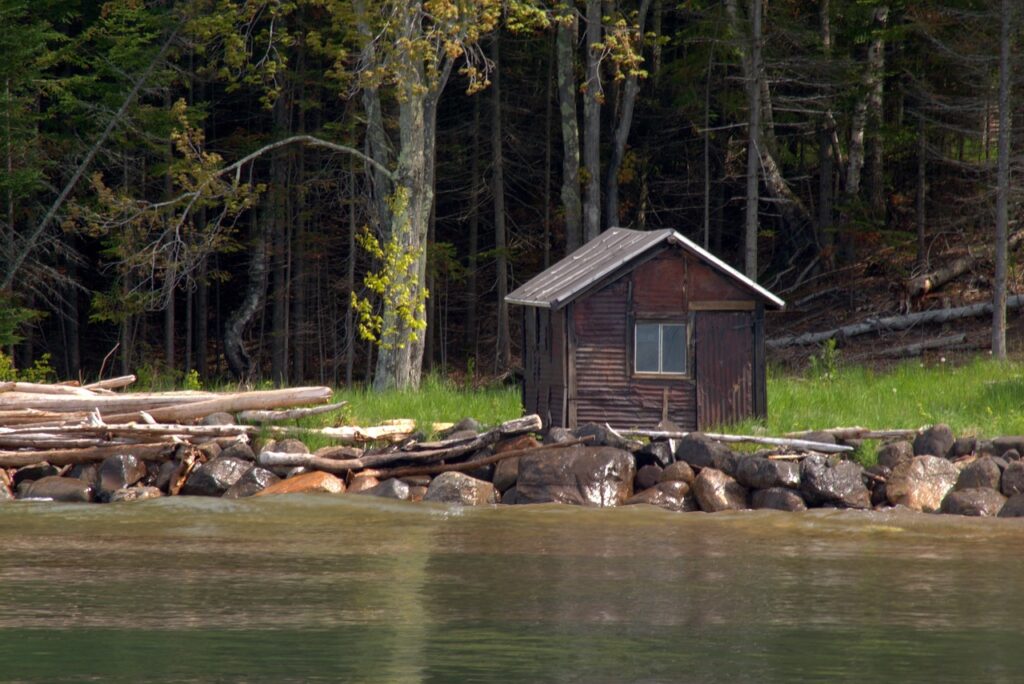Have you craved to get transported to the Instagram aesthetics of the countryside? If yes, this means these days you are craving for an off-grid life. Well, let’s take you into it today!
Ever feel like you’re constantly chasing the next paycheck, just to keep up with the ever-increasing cost of living?
Or maybe you’re simply tired of the hustle of modern life, yearning for a simpler, more meaningful existence.
If you’ve ever fantasized about ditching the rat race, growing your own food, and living in harmony with nature, then the concept of “off-grid living” might be “the one” for you.
In this blog post, I’ll dive into what off-grid living really means, explore the challenges and rewards it offers, and provide a roadmap for how you can start building your own off-grid life.
What is an Off-Grid Life? 4 Ways You Can Build it For Yourself
Have you ever stared at a sky-high electric bill and thought, “There’s gotta be a better way”?
Or maybe the daily grind of work, traffic, and endless to-do lists has you longing for a simpler, more fulfilling life? If yes, then off-grid life might be calling your name.
But what exactly does it mean to live “off the grid”?
Simply put, it means ditching your reliance on public utilities like electricity, water, and sewage systems.
It’s about embracing a life where you produce your own power, collect your own water, and manage your own waste.
It might sound a bit extreme, but for many, it’s a path toward freedom, sustainability, and a closer connection to nature.
Now, before you start packing your bags for a remote cabin in the woods, let’s be real: off-grid living isn’t for the faint-hearted. It requires a good deal of planning, resourcefulness, and a willingness to roll up your sleeves and get your hands dirty. But for those who crave a life less ordinary, the rewards can be immense.
Imagine waking up to the sound of birdsong instead of traffic, growing your own food, and knowing that you’re treading lightly on the planet. Sounds pretty tempting, right?
4 Benefits of Living the Off-Grid Life
Okay, so you’re intrigued by the idea of off-grid life. But what’s in it for you?
Let’s dive into the benefits, and spoiler alert: it’s not just about saving money (Although that’s nice too).
1. Environmental Responsibility
By generating your own renewable energy and managing your resources responsibly, an off-grid life significantly reduces your environmental impact.
This lifestyle promotes a smaller carbon footprint and a more sustainable approach to daily life.
2. Financial Independence
Yes, living an off-grid life can save you a bundle in the long run.
Imagine no more shocking utility bills or surprise rate hikes. You’ll be in control of your energy and water usage, which can translate to major savings.
But the benefits go beyond just money.
By learning to fix things yourself and relying on your own resources, you’ll become incredibly self-sufficient, a skill that’s priceless in any situation.
3. Personal Growth and Resilience
An off-grid life isn’t for the timid. It’s a challenge that pushes you to learn new skills, adapt to unpredictable situations, and become a master problem-solver.
You’ll gain confidence, resilience, and appreciation for the little things in life.
Plus, spending more time in nature has been shown to have a profound positive impact on mental health.
4. Say Goodbye to Stress (Well, Most of It)
Let’s face it, modern life can be overwhelming. The constant hustle and bustle, endless notifications, and pressure to keep up with the trends can take a toll on your well-being.
Off-grid living offers a simpler, slower-paced lifestyle that allows you to disconnect from the noise and reconnect with what truly matters.
Imagine having more time for your hobbies, spending quality time with the people you love, and simply enjoying the peace and quiet. It’s a recipe for reduced stress and a happier, healthier you.

4 Challenges of Living an Off-Grid Life:
Okay, let’s not sugarcoat it: off-grid living isn’t all sunshine and rainbows. It comes with its fair share of challenges, so if you’re preparing for it, it’s important to be aware of what you’re getting into.
1. Money Talks (And Sometimes It’s Expensive)
Setting up an off-grid home isn’t cheap.
You’ll need to invest in land, a home (or materials to build one), and all the systems to generate power, collect water, and manage waste.
Think of it as a long-term investment in your freedom and sustainability.
2. The learning never stops
Don’t expect to become an off-grid expert overnight.
You’ll be learning new skills like a pro – from installing solar panels to fixing plumbing issues to growing your own food.
It’s a constant adventure, but that’s part of the fun!
3. Maintenance matters
Just like your regular home, an off-grid home requires regular upkeep.
You’ll need to keep an eye on your solar panels, water systems, and everything else to make sure it’s running smoothly.
It’s a bit more hands-on than just calling a repairman, but it’s also empowering to be in control.
4. Sometimes it gets lonely (But you can fix that)
If you’re used to having neighbors nearby and popping to the store whenever you need something, off-grid living can feel a bit isolating at first.
But with a little effort, you can build a supportive community of fellow off-gridders or find creative ways to stay connected with the outside world.
So, yeah, off-grid living isn’t a walk in the park. But for many people, the challenges are far outweighed by the rewards of a simpler, more self-sufficient life. If you’re up for an adventure and willing to put in the work, it can be a truly fulfilling journey.
Off-Grid Life Essentials: What You Need to Live on Your Own
So, you’re ready to live the off-grid life? Awesome!
But you’ll need a few things to make it happen. Here’s what you need to think about:
1. Electricity
Since you won’t be plugged into the city’s power, you’ll need your own way to make electricity.
Think solar panels soaking up the sun’s energy, windmills spinning in the breeze, or even a generator for backup power.
2. Water
You gotta stay hydrated!
Digging a well is a common way to get water, but you can also collect rainwater or use water from a nearby stream if it’s clean.
And don’t forget a way to clean the water, like a filter, so it’s safe to drink.
3. Toilet Time
No, you don’t have to dig a hole in the ground!
There are special toilets called composting toilets that break down waste naturally.
Or, you can go with a regular septic system like most houses have.
4. Grow your own food(Optional)
Imagine having fresh veggies from your own garden!
Even if you don’t have a lot of space, you can grow some food in pots or raised beds. You can even build your own kitchen herb garden.
If you’re up for it, you could even have chickens for eggs or a couple of goats for milk.
There you have it! These are the basic things you need to get started on your off-grid adventure.
Choosing the Right Location:
So, you’re sold on building the off-grid lifestyle.
Now, the next big question is: where do you set up your home?
Choosing the right location is like picking the perfect campsite – it can make or break your experience.
1. First things first, do your homework on the local rules and regulations. Some areas have strict rules about what you can and can’t do on your land, especially when it comes to building off-grid.
So, make sure you know what you’re getting into before you buy that dream property.
2. Next, think about the weather. If you’re dreaming of solar power, you’ll need a spot with plenty of sunshine and if you’re planning to collect rainwater, you’ll want an area with decent rainfall.
Of course, you’ll also want to consider extreme temperatures – will you be able to stay warm in the winter and cool in the summer?
3. Finally, consider the resources available in the area.
- Is there a reliable source of water nearby?
- Are there building materials available, or will you have to haul them in from miles away?
4. Don’t forget about the community! Having neighbors who are also living off-grid can be a huge support system, especially when you’re first getting started.
Choosing the right location for your off-grid adventure is a big decision, but with a little research and some careful consideration, you can find the perfect spot to build your dream home.
Building Your Off-Grid Home: Tiny, Traditional, or Totally Unique?
Alright, now let’s get into the fun part: designing and building your off-grid dream home!
This is where you get to let your imagination run wild and create a space that’s uniquely yours.
What kind of home are you dreaming of?
- Tiny Homes: If you’re into minimalism and want to downsize your life, a tiny home might be perfect. These cute little houses are super efficient and affordable, plus they have a smaller environmental impact.
- Cabins: A cozy cabin in the woods is a classic off-grid dream. They’re often made of natural materials and blend in with the surrounding environment. Plus, who doesn’t love curling up by a wood-burning stove on a chilly night?
- Earthships: These unique homes are partially built into the earth, which helps regulate temperature and conserve energy. They often use recycled materials and have a super cool, futuristic look.
- RVs: If you love the idea of hitting the open road and exploring different off-grid locations, an RV could be your home on wheels. They’re fully equipped with everything you need, and you can park them wherever you find a beautiful view.
What’s it going to be made of?
Once you decide what type of home you want for your off-grid life, the next concern is what should be the material of your home.
- Wood: A classic choice for cabins and homes, wood is a natural, renewable resource that’s relatively easy to work with.
- Straw Bales: These surprisingly sturdy building blocks are made from agricultural waste and offer excellent insulation.
- Recycled Materials: Get creative and use recycled materials like shipping containers, old tires, or even glass bottles to build your off-grid home. It’s a great way to reduce your waste and save money.
Should you DIY or hire an expert?
- DIY: Building your own home can be a rewarding experience, but it’s definitely not for everyone. You’ll need some serious skills and a lot of time and patience.
- Professional Builder: If you’re not a DIY expert, hiring a professional builder can save you a lot of headaches. Just make sure to find someone who understands the unique challenges of off-grid construction.
Ultimately, the best choice for you will depend on your budget, skills, and personal preferences. Thus, make sure you do your research, explore your options, and don’t be afraid to think outside the box!
Living Off-Grid: 4 Tips & Tricks to Make It Work
So, you’ve got your off-grid home all set up. Now, it’s time to figure out how to actually live this lifestyle day to day.
While it’s different from your day-to-day lifestyle, it’s all about being smart with your resources and finding clever ways to make things work. Let’s help you do that!
1. Power smart
When you’re off the grid, electricity is a precious resource.
You’ll want to use energy-saving appliances that don’t drink power, switch to LED light bulbs that last longer, and maybe even use a smart thermostat to help you control your heating and cooling.
2. Water wise
Water is just as important as electricity, and it’s even more precious when you’re not hooked up to the city supply.
So, switch to low-flow faucets and showerheads, which use less water. Consider collecting rainwater in barrels or tanks to use for your garden or even to flush your toilet.
Did you know you can even reuse water from your shower and sinks (it’s called greywater) to water your plants?
3. Food for thought
If you’re growing your own food, you’ll need to figure out how to store it for when your garden isn’t producing.
Canning and drying are great ways to preserve fruits and veggies, and if you have the space, a root cellar is a cool place to keep things like potatoes and carrots fresh.
4. Find Your Off-Grid Tribe
Even though you’re living off the grid, you don’t have to be completely alone.
There are lots of other people doing the same thing, and they can be a great source of information and support.
Find online forums or groups in your area where you can connect with fellow off-gridders and exchange some tips and tricks to sail your boat.
Conclusion
So, there you have it: your guide on living the off-grid life.
Living off the grid is about taking control of your life, living on your own terms, and building a deeper connection with nature and yourself.
Sure, it comes with challenges, but for those who are up for the adventure, it can be an incredibly rewarding way of life.
Who knows, you might just find that a little sunshine, some elbow grease, and a whole lot of creativity are all you need to create the life you’ve always dreamed of.
So, go ahead, ditch the grid, and let your off-grid adventure begin!



